Strategic Change Management Report: HSBC Bank's Transformation
VerifiedAdded on 2021/02/19
|20
|6267
|627
Report
AI Summary
This report provides a comprehensive analysis of strategic change management, focusing on its application within HSBC bank. It begins with an executive summary and introduction, outlining the importance of strategic change for organizational success. The report then presents various models of strategic change, including Lewin's, ADKAR, and Kotter's models, evaluating their relevance and effectiveness in the context of HSBC's technological challenges. It explores the value of strategic intervention techniques, such as Techno-structural intervention, in facilitating change and fostering cooperation. The study identifies the key drivers for strategic change within firms, such as market fluctuations, economic downturns, customer expectations, and technological advancements. The report further examines internal and external factors influencing the need for change, including employee dynamics, customer behavior, and digital disruptions. It also delves into systems for involving stakeholders in the planning process, develops change management strategies, and addresses strategies for managing resistance to change. The report concludes by recommending appropriate change models and measures for monitoring progress, providing a roadmap for successful strategic transformation within HSBC. The report also highlights the importance of continuous innovation and adaptation to stay competitive in the market.
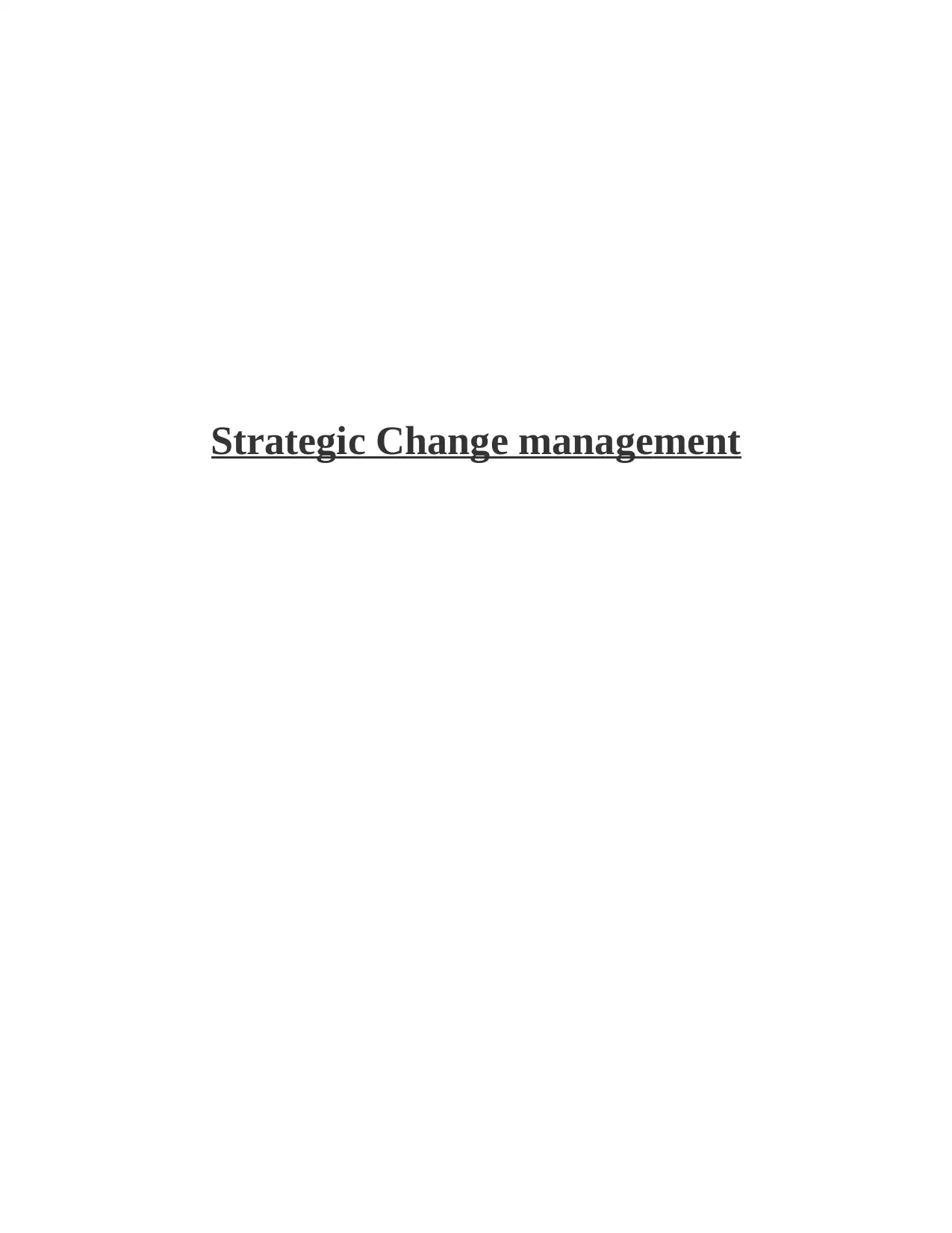
Strategic Change management
Paraphrase This Document
Need a fresh take? Get an instant paraphrase of this document with our AI Paraphraser

Executive summary
Strategic change management allow organization to carefully make changes in their
business and it is a well structured plan that helps to meet the organization goals and objectives.
Through this report, researcher and learners gain knowledge related to change management
system. Chosen firm for this is HSBC bank which is British Multinational investment bank who
also wants to make strategic changes. Through the report, researcher gain three different types of
strategic change management tool and describe the need of opting the same. Further, the report
will also describe the system that is involve in stakeholders for planning the change and also
evaluate the system as well. Then, with the help of two change management model, it describe
some challenges face by the firm.
Strategic change management allow organization to carefully make changes in their
business and it is a well structured plan that helps to meet the organization goals and objectives.
Through this report, researcher and learners gain knowledge related to change management
system. Chosen firm for this is HSBC bank which is British Multinational investment bank who
also wants to make strategic changes. Through the report, researcher gain three different types of
strategic change management tool and describe the need of opting the same. Further, the report
will also describe the system that is involve in stakeholders for planning the change and also
evaluate the system as well. Then, with the help of two change management model, it describe
some challenges face by the firm.
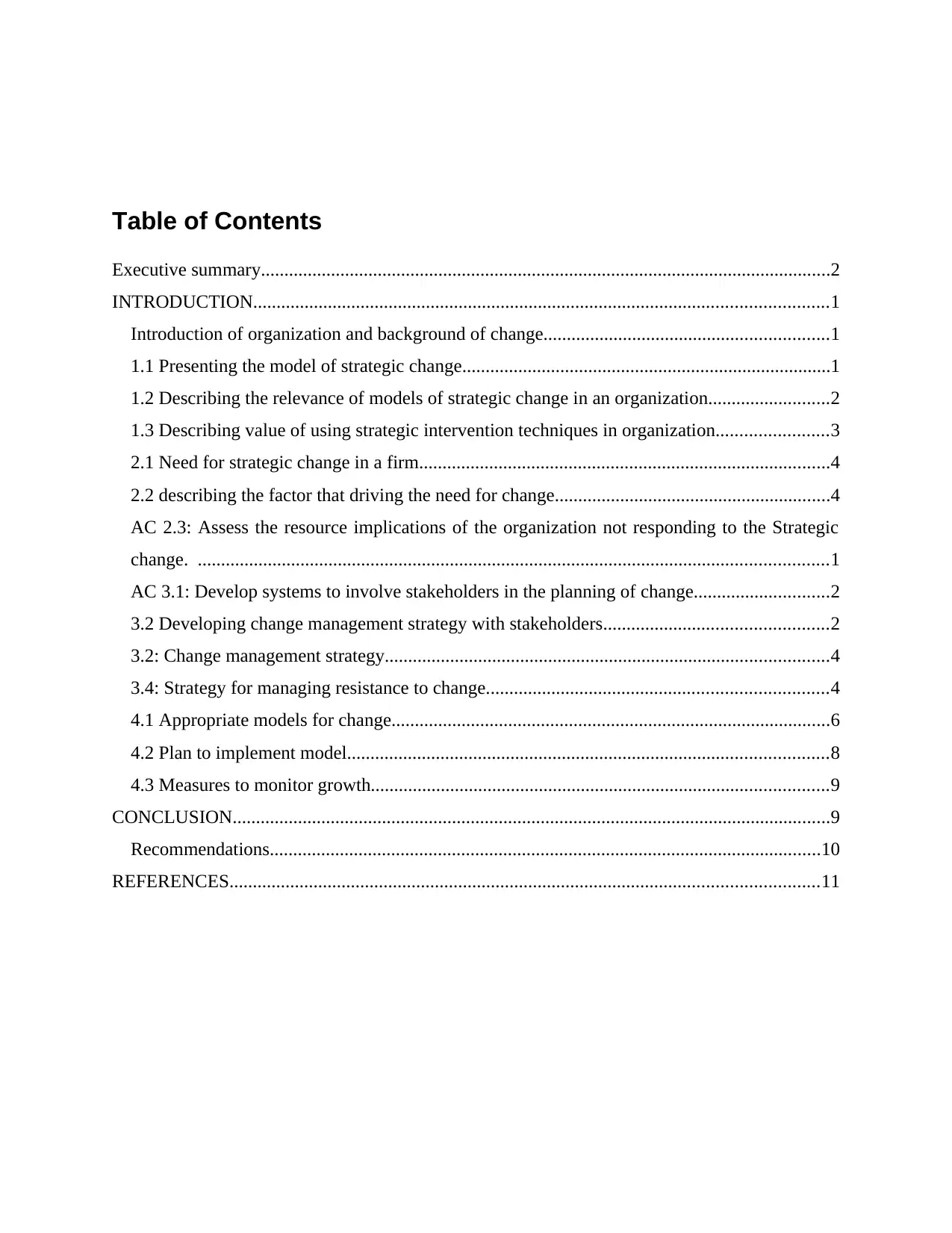
Table of Contents
Executive summary..........................................................................................................................2
INTRODUCTION...........................................................................................................................1
Introduction of organization and background of change.............................................................1
1.1 Presenting the model of strategic change...............................................................................1
1.2 Describing the relevance of models of strategic change in an organization..........................2
1.3 Describing value of using strategic intervention techniques in organization........................3
2.1 Need for strategic change in a firm........................................................................................4
2.2 describing the factor that driving the need for change...........................................................4
AC 2.3: Assess the resource implications of the organization not responding to the Strategic
change. .......................................................................................................................................1
AC 3.1: Develop systems to involve stakeholders in the planning of change.............................2
3.2 Developing change management strategy with stakeholders................................................2
3.2: Change management strategy...............................................................................................4
3.4: Strategy for managing resistance to change.........................................................................4
4.1 Appropriate models for change..............................................................................................6
4.2 Plan to implement model.......................................................................................................8
4.3 Measures to monitor growth..................................................................................................9
CONCLUSION................................................................................................................................9
Recommendations......................................................................................................................10
REFERENCES..............................................................................................................................11
Executive summary..........................................................................................................................2
INTRODUCTION...........................................................................................................................1
Introduction of organization and background of change.............................................................1
1.1 Presenting the model of strategic change...............................................................................1
1.2 Describing the relevance of models of strategic change in an organization..........................2
1.3 Describing value of using strategic intervention techniques in organization........................3
2.1 Need for strategic change in a firm........................................................................................4
2.2 describing the factor that driving the need for change...........................................................4
AC 2.3: Assess the resource implications of the organization not responding to the Strategic
change. .......................................................................................................................................1
AC 3.1: Develop systems to involve stakeholders in the planning of change.............................2
3.2 Developing change management strategy with stakeholders................................................2
3.2: Change management strategy...............................................................................................4
3.4: Strategy for managing resistance to change.........................................................................4
4.1 Appropriate models for change..............................................................................................6
4.2 Plan to implement model.......................................................................................................8
4.3 Measures to monitor growth..................................................................................................9
CONCLUSION................................................................................................................................9
Recommendations......................................................................................................................10
REFERENCES..............................................................................................................................11
⊘ This is a preview!⊘
Do you want full access?
Subscribe today to unlock all pages.

Trusted by 1+ million students worldwide
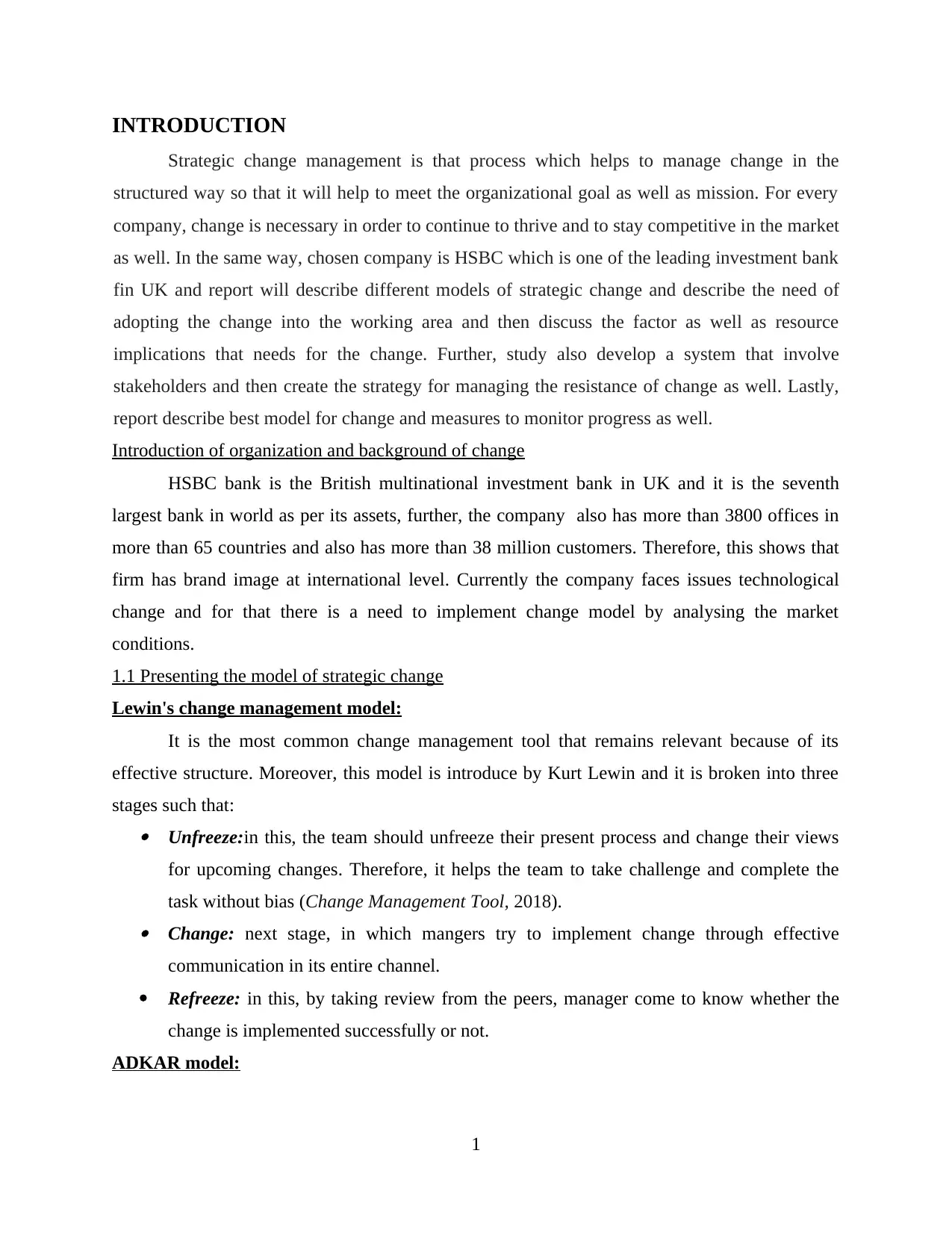
INTRODUCTION
Strategic change management is that process which helps to manage change in the
structured way so that it will help to meet the organizational goal as well as mission. For every
company, change is necessary in order to continue to thrive and to stay competitive in the market
as well. In the same way, chosen company is HSBC which is one of the leading investment bank
fin UK and report will describe different models of strategic change and describe the need of
adopting the change into the working area and then discuss the factor as well as resource
implications that needs for the change. Further, study also develop a system that involve
stakeholders and then create the strategy for managing the resistance of change as well. Lastly,
report describe best model for change and measures to monitor progress as well.
Introduction of organization and background of change
HSBC bank is the British multinational investment bank in UK and it is the seventh
largest bank in world as per its assets, further, the company also has more than 3800 offices in
more than 65 countries and also has more than 38 million customers. Therefore, this shows that
firm has brand image at international level. Currently the company faces issues technological
change and for that there is a need to implement change model by analysing the market
conditions.
1.1 Presenting the model of strategic change
Lewin's change management model:
It is the most common change management tool that remains relevant because of its
effective structure. Moreover, this model is introduce by Kurt Lewin and it is broken into three
stages such that: Unfreeze:in this, the team should unfreeze their present process and change their views
for upcoming changes. Therefore, it helps the team to take challenge and complete the
task without bias (Change Management Tool, 2018). Change: next stage, in which mangers try to implement change through effective
communication in its entire channel.
Refreeze: in this, by taking review from the peers, manager come to know whether the
change is implemented successfully or not.
ADKAR model:
1
Strategic change management is that process which helps to manage change in the
structured way so that it will help to meet the organizational goal as well as mission. For every
company, change is necessary in order to continue to thrive and to stay competitive in the market
as well. In the same way, chosen company is HSBC which is one of the leading investment bank
fin UK and report will describe different models of strategic change and describe the need of
adopting the change into the working area and then discuss the factor as well as resource
implications that needs for the change. Further, study also develop a system that involve
stakeholders and then create the strategy for managing the resistance of change as well. Lastly,
report describe best model for change and measures to monitor progress as well.
Introduction of organization and background of change
HSBC bank is the British multinational investment bank in UK and it is the seventh
largest bank in world as per its assets, further, the company also has more than 3800 offices in
more than 65 countries and also has more than 38 million customers. Therefore, this shows that
firm has brand image at international level. Currently the company faces issues technological
change and for that there is a need to implement change model by analysing the market
conditions.
1.1 Presenting the model of strategic change
Lewin's change management model:
It is the most common change management tool that remains relevant because of its
effective structure. Moreover, this model is introduce by Kurt Lewin and it is broken into three
stages such that: Unfreeze:in this, the team should unfreeze their present process and change their views
for upcoming changes. Therefore, it helps the team to take challenge and complete the
task without bias (Change Management Tool, 2018). Change: next stage, in which mangers try to implement change through effective
communication in its entire channel.
Refreeze: in this, by taking review from the peers, manager come to know whether the
change is implemented successfully or not.
ADKAR model:
1
Paraphrase This Document
Need a fresh take? Get an instant paraphrase of this document with our AI Paraphraser
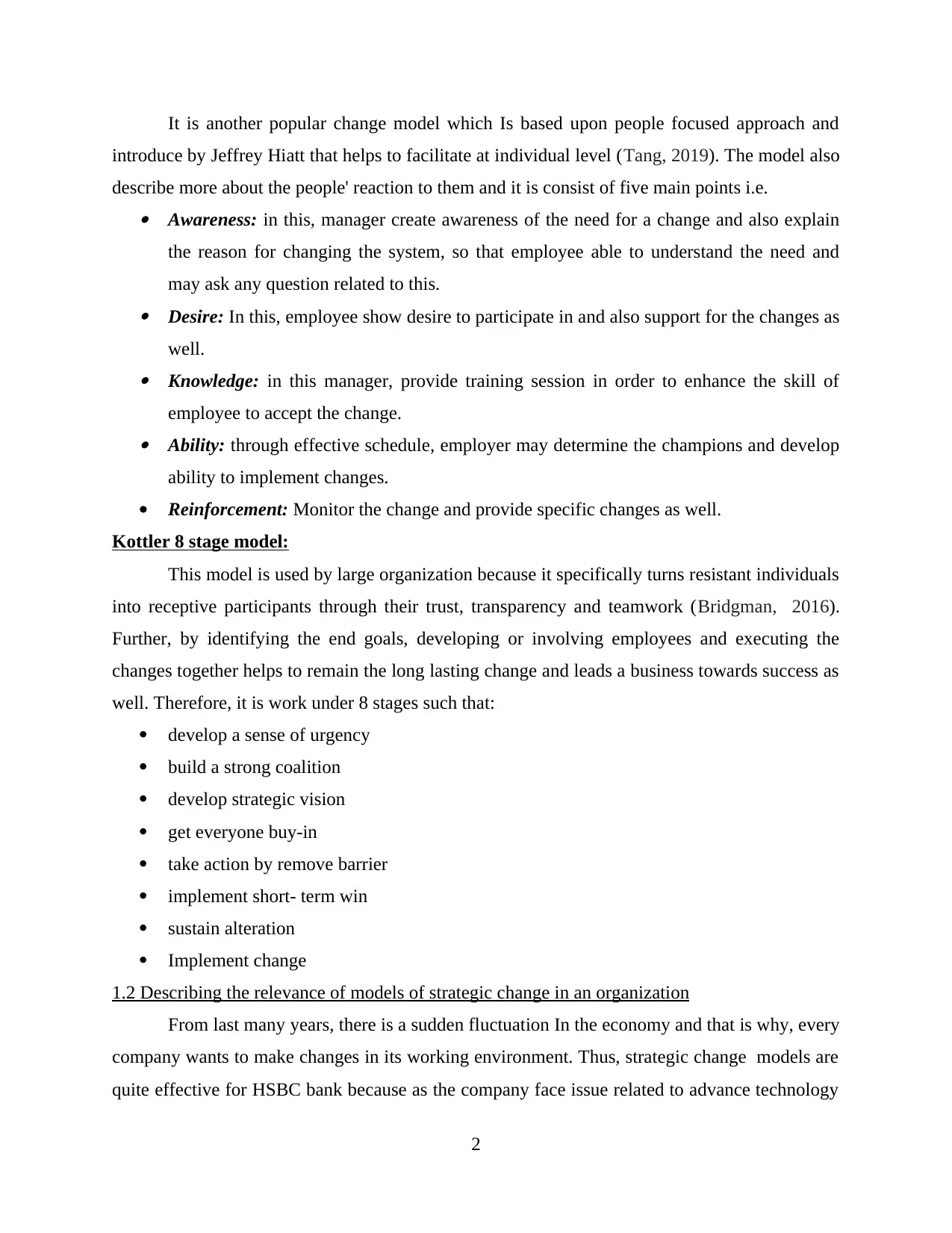
It is another popular change model which Is based upon people focused approach and
introduce by Jeffrey Hiatt that helps to facilitate at individual level (Tang, 2019). The model also
describe more about the people' reaction to them and it is consist of five main points i.e. Awareness: in this, manager create awareness of the need for a change and also explain
the reason for changing the system, so that employee able to understand the need and
may ask any question related to this. Desire: In this, employee show desire to participate in and also support for the changes as
well. Knowledge: in this manager, provide training session in order to enhance the skill of
employee to accept the change. Ability: through effective schedule, employer may determine the champions and develop
ability to implement changes.
Reinforcement: Monitor the change and provide specific changes as well.
Kottler 8 stage model:
This model is used by large organization because it specifically turns resistant individuals
into receptive participants through their trust, transparency and teamwork (Bridgman, 2016).
Further, by identifying the end goals, developing or involving employees and executing the
changes together helps to remain the long lasting change and leads a business towards success as
well. Therefore, it is work under 8 stages such that:
develop a sense of urgency
build a strong coalition
develop strategic vision
get everyone buy-in
take action by remove barrier
implement short- term win
sustain alteration
Implement change
1.2 Describing the relevance of models of strategic change in an organization
From last many years, there is a sudden fluctuation In the economy and that is why, every
company wants to make changes in its working environment. Thus, strategic change models are
quite effective for HSBC bank because as the company face issue related to advance technology
2
introduce by Jeffrey Hiatt that helps to facilitate at individual level (Tang, 2019). The model also
describe more about the people' reaction to them and it is consist of five main points i.e. Awareness: in this, manager create awareness of the need for a change and also explain
the reason for changing the system, so that employee able to understand the need and
may ask any question related to this. Desire: In this, employee show desire to participate in and also support for the changes as
well. Knowledge: in this manager, provide training session in order to enhance the skill of
employee to accept the change. Ability: through effective schedule, employer may determine the champions and develop
ability to implement changes.
Reinforcement: Monitor the change and provide specific changes as well.
Kottler 8 stage model:
This model is used by large organization because it specifically turns resistant individuals
into receptive participants through their trust, transparency and teamwork (Bridgman, 2016).
Further, by identifying the end goals, developing or involving employees and executing the
changes together helps to remain the long lasting change and leads a business towards success as
well. Therefore, it is work under 8 stages such that:
develop a sense of urgency
build a strong coalition
develop strategic vision
get everyone buy-in
take action by remove barrier
implement short- term win
sustain alteration
Implement change
1.2 Describing the relevance of models of strategic change in an organization
From last many years, there is a sudden fluctuation In the economy and that is why, every
company wants to make changes in its working environment. Thus, strategic change models are
quite effective for HSBC bank because as the company face issue related to advance technology
2

and that is why, with the help of model, company may easily accept the change. For the same, all
above mentioned three models are quite effective to use because by using Kurt Lewin change
management model, HSBC cuts out a lot of complexity and fluff which are involve in other
model and by implementing the same, company's employees easily understand to implement the
change and as a result, it makes easy to plan around and it also try to minimize the difficulty as
well (Bakaria, Hunjrab and Masood, 2017). Moreover, this change management model helps to
reject the fear of change among employees so that they will survive in the difficult situation.
On the other side, there is a need to implement the technology change into the working
area and for that, ADKAR model is also used for implementing change because it focus on
results as compared to task. Even it also provide the checklist of things which need to be done to
manage change. Therefore, as the model provides practical approach of change management and
by providing effective training system, company may implement the same. On the other side,
Kottler eight stage model also helps to create support and make employees aware to accept the
employees and it is possible only if the company have new vision. Through this model, HSBC
also take opinions from their employees and then make final decision too.
1.3 Describing value of using strategic intervention techniques in organization
As per the view of Burnes and Bargal, (2017) strategic change is the key that lead a firm
towards better future performance, but the manager may faces different issues or challenges
while implementing strategic planning. That is why, by adopting strategic intervention
techniques, company may creates cooperation between manager and team workers. Therefore, a
systematic implementation of change is intended to impact upon business basic, but the strategic
intervention used to facilitate change in an organization structure so that it will more rapidly
accept the changes i.e. disruptive technology, high competition and fluctuation in market.
Therefore, by using strategic intervention techniques such as Techno structural intervention by
HSBC Bank which is completely based upon technology and structure so that it will help to cope
up the issue.
On the other side, this strategy also deliver the best results for the company. For example,
using this intervention, quoted firm saves time and develop new programs that helps to reduce
cost and also attract wide range of customers too. Moreover, by using the strategic intervention
technique, HSBC develop opportunities for developing growth options and it also provide
3
above mentioned three models are quite effective to use because by using Kurt Lewin change
management model, HSBC cuts out a lot of complexity and fluff which are involve in other
model and by implementing the same, company's employees easily understand to implement the
change and as a result, it makes easy to plan around and it also try to minimize the difficulty as
well (Bakaria, Hunjrab and Masood, 2017). Moreover, this change management model helps to
reject the fear of change among employees so that they will survive in the difficult situation.
On the other side, there is a need to implement the technology change into the working
area and for that, ADKAR model is also used for implementing change because it focus on
results as compared to task. Even it also provide the checklist of things which need to be done to
manage change. Therefore, as the model provides practical approach of change management and
by providing effective training system, company may implement the same. On the other side,
Kottler eight stage model also helps to create support and make employees aware to accept the
employees and it is possible only if the company have new vision. Through this model, HSBC
also take opinions from their employees and then make final decision too.
1.3 Describing value of using strategic intervention techniques in organization
As per the view of Burnes and Bargal, (2017) strategic change is the key that lead a firm
towards better future performance, but the manager may faces different issues or challenges
while implementing strategic planning. That is why, by adopting strategic intervention
techniques, company may creates cooperation between manager and team workers. Therefore, a
systematic implementation of change is intended to impact upon business basic, but the strategic
intervention used to facilitate change in an organization structure so that it will more rapidly
accept the changes i.e. disruptive technology, high competition and fluctuation in market.
Therefore, by using strategic intervention techniques such as Techno structural intervention by
HSBC Bank which is completely based upon technology and structure so that it will help to cope
up the issue.
On the other side, this strategy also deliver the best results for the company. For example,
using this intervention, quoted firm saves time and develop new programs that helps to reduce
cost and also attract wide range of customers too. Moreover, by using the strategic intervention
technique, HSBC develop opportunities for developing growth options and it also provide
3
⊘ This is a preview!⊘
Do you want full access?
Subscribe today to unlock all pages.

Trusted by 1+ million students worldwide
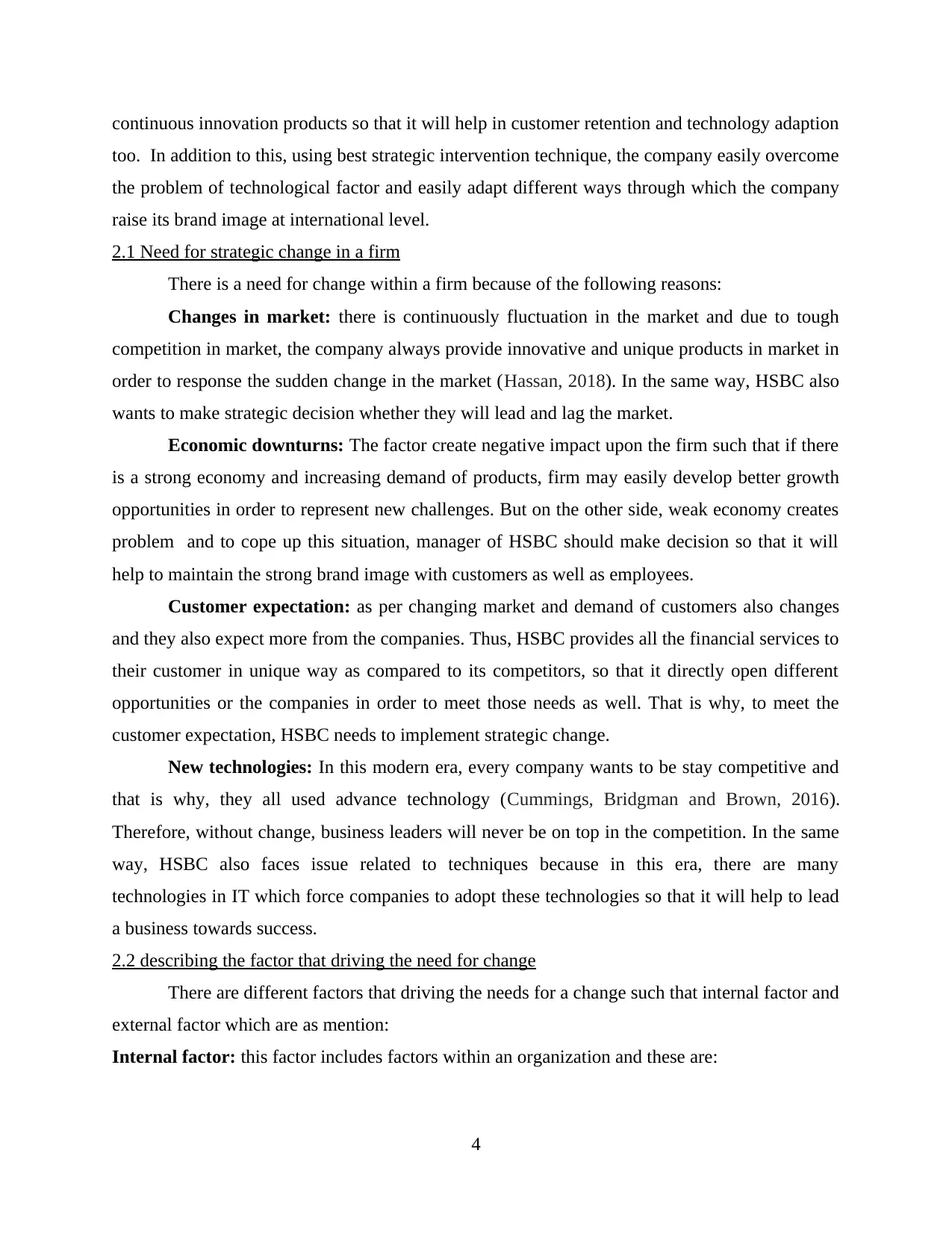
continuous innovation products so that it will help in customer retention and technology adaption
too. In addition to this, using best strategic intervention technique, the company easily overcome
the problem of technological factor and easily adapt different ways through which the company
raise its brand image at international level.
2.1 Need for strategic change in a firm
There is a need for change within a firm because of the following reasons:
Changes in market: there is continuously fluctuation in the market and due to tough
competition in market, the company always provide innovative and unique products in market in
order to response the sudden change in the market (Hassan, 2018). In the same way, HSBC also
wants to make strategic decision whether they will lead and lag the market.
Economic downturns: The factor create negative impact upon the firm such that if there
is a strong economy and increasing demand of products, firm may easily develop better growth
opportunities in order to represent new challenges. But on the other side, weak economy creates
problem and to cope up this situation, manager of HSBC should make decision so that it will
help to maintain the strong brand image with customers as well as employees.
Customer expectation: as per changing market and demand of customers also changes
and they also expect more from the companies. Thus, HSBC provides all the financial services to
their customer in unique way as compared to its competitors, so that it directly open different
opportunities or the companies in order to meet those needs as well. That is why, to meet the
customer expectation, HSBC needs to implement strategic change.
New technologies: In this modern era, every company wants to be stay competitive and
that is why, they all used advance technology (Cummings, Bridgman and Brown, 2016).
Therefore, without change, business leaders will never be on top in the competition. In the same
way, HSBC also faces issue related to techniques because in this era, there are many
technologies in IT which force companies to adopt these technologies so that it will help to lead
a business towards success.
2.2 describing the factor that driving the need for change
There are different factors that driving the needs for a change such that internal factor and
external factor which are as mention:
Internal factor: this factor includes factors within an organization and these are:
4
too. In addition to this, using best strategic intervention technique, the company easily overcome
the problem of technological factor and easily adapt different ways through which the company
raise its brand image at international level.
2.1 Need for strategic change in a firm
There is a need for change within a firm because of the following reasons:
Changes in market: there is continuously fluctuation in the market and due to tough
competition in market, the company always provide innovative and unique products in market in
order to response the sudden change in the market (Hassan, 2018). In the same way, HSBC also
wants to make strategic decision whether they will lead and lag the market.
Economic downturns: The factor create negative impact upon the firm such that if there
is a strong economy and increasing demand of products, firm may easily develop better growth
opportunities in order to represent new challenges. But on the other side, weak economy creates
problem and to cope up this situation, manager of HSBC should make decision so that it will
help to maintain the strong brand image with customers as well as employees.
Customer expectation: as per changing market and demand of customers also changes
and they also expect more from the companies. Thus, HSBC provides all the financial services to
their customer in unique way as compared to its competitors, so that it directly open different
opportunities or the companies in order to meet those needs as well. That is why, to meet the
customer expectation, HSBC needs to implement strategic change.
New technologies: In this modern era, every company wants to be stay competitive and
that is why, they all used advance technology (Cummings, Bridgman and Brown, 2016).
Therefore, without change, business leaders will never be on top in the competition. In the same
way, HSBC also faces issue related to techniques because in this era, there are many
technologies in IT which force companies to adopt these technologies so that it will help to lead
a business towards success.
2.2 describing the factor that driving the need for change
There are different factors that driving the needs for a change such that internal factor and
external factor which are as mention:
Internal factor: this factor includes factors within an organization and these are:
4
Paraphrase This Document
Need a fresh take? Get an instant paraphrase of this document with our AI Paraphraser
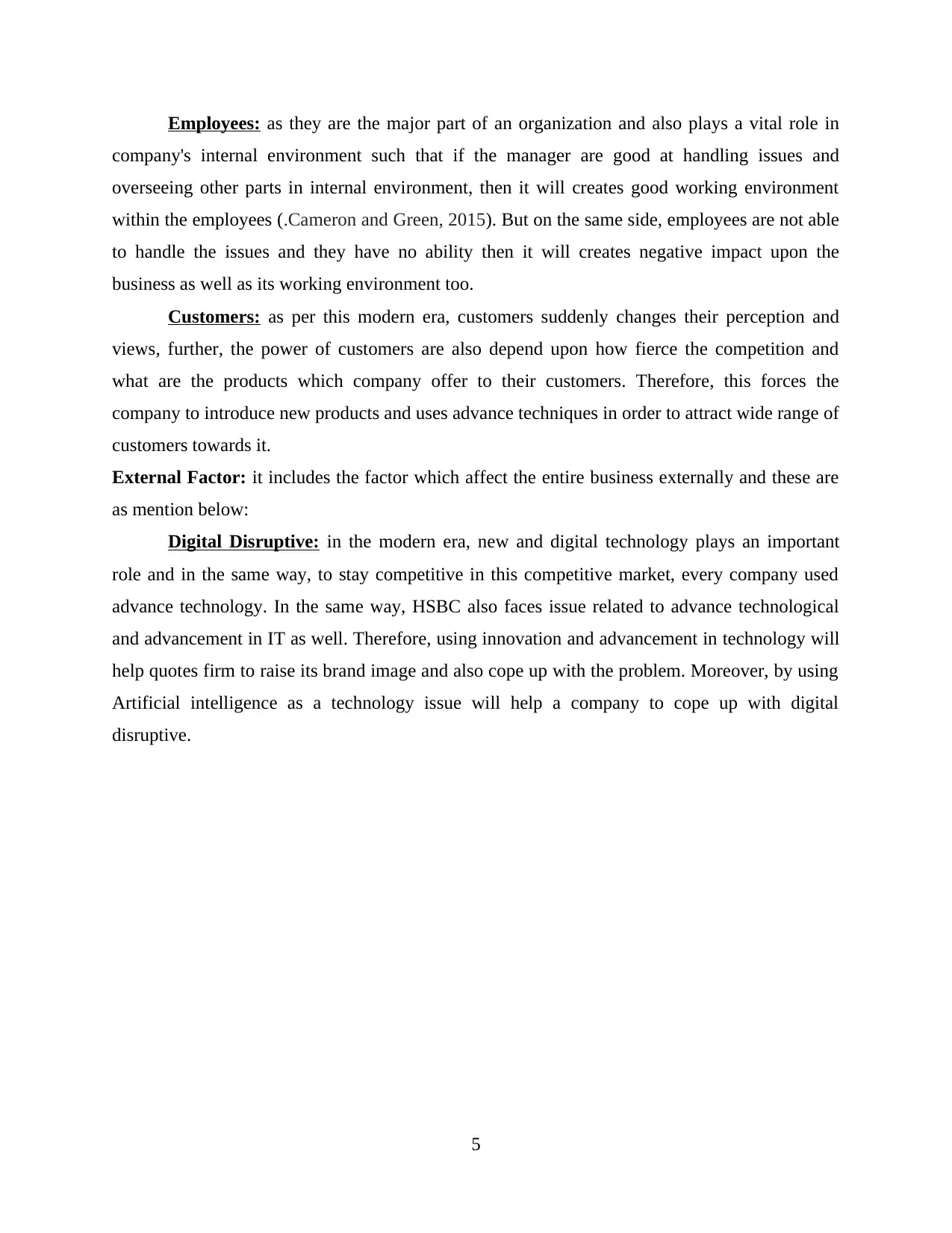
Employees: as they are the major part of an organization and also plays a vital role in
company's internal environment such that if the manager are good at handling issues and
overseeing other parts in internal environment, then it will creates good working environment
within the employees (.Cameron and Green, 2015). But on the same side, employees are not able
to handle the issues and they have no ability then it will creates negative impact upon the
business as well as its working environment too.
Customers: as per this modern era, customers suddenly changes their perception and
views, further, the power of customers are also depend upon how fierce the competition and
what are the products which company offer to their customers. Therefore, this forces the
company to introduce new products and uses advance techniques in order to attract wide range of
customers towards it.
External Factor: it includes the factor which affect the entire business externally and these are
as mention below:
Digital Disruptive: in the modern era, new and digital technology plays an important
role and in the same way, to stay competitive in this competitive market, every company used
advance technology. In the same way, HSBC also faces issue related to advance technological
and advancement in IT as well. Therefore, using innovation and advancement in technology will
help quotes firm to raise its brand image and also cope up with the problem. Moreover, by using
Artificial intelligence as a technology issue will help a company to cope up with digital
disruptive.
5
company's internal environment such that if the manager are good at handling issues and
overseeing other parts in internal environment, then it will creates good working environment
within the employees (.Cameron and Green, 2015). But on the same side, employees are not able
to handle the issues and they have no ability then it will creates negative impact upon the
business as well as its working environment too.
Customers: as per this modern era, customers suddenly changes their perception and
views, further, the power of customers are also depend upon how fierce the competition and
what are the products which company offer to their customers. Therefore, this forces the
company to introduce new products and uses advance techniques in order to attract wide range of
customers towards it.
External Factor: it includes the factor which affect the entire business externally and these are
as mention below:
Digital Disruptive: in the modern era, new and digital technology plays an important
role and in the same way, to stay competitive in this competitive market, every company used
advance technology. In the same way, HSBC also faces issue related to advance technological
and advancement in IT as well. Therefore, using innovation and advancement in technology will
help quotes firm to raise its brand image and also cope up with the problem. Moreover, by using
Artificial intelligence as a technology issue will help a company to cope up with digital
disruptive.
5

AC 2.3: Assess the resource implications of the organization not responding to the Strategic
change.
If HSBC is not engaged in following or responding to change then following implications can
occur in company. This includes the following:
Human and physical resources- It has been analysed that HSBC is involved in bringing
technological changes. For this they need to have support from all the employees
working in organization. Company for proper implication can engage into restructuring
of the organization structure. They also need to provide proper training and learning to
employees so that the modifications can be properly established. This can support firm
in overcoming the conflicts which might be face by them during the time they are
implementing changes. HSBC can also engage in hiring new and efficient workers so
that they can easily survive during the time of changes. It would also be easier for them
to understand about the technological changes which are being implemented in firm. If
Human resource of company is being properly trained, then it will also support HSBC
in increasing their operational efficiency and productivity(North and Kumta, 2018).
This will also assist firm in growing and implementing the change in properly and
efficiently.
Financial resources- If the Technological change which is going in and on in HSBC is not being
properly implemented then it can increase the operational cost of business. It can also
increase the cost related to training, learning and development. Changes perceived as
negative drain resources further, making it difficult to cope with and implement change.
Also company must make sure that every employee must be aware about the changes
which is going in organization, so that employees of HSBC make effective use of
resources. This will help company in saving cost and reducing the expenses related to
training and learning. Employees must adapt to many changes beyond those identified
as planned change initiatives. Prioritize, sequence, and coordinate changes throughout
the organization to reduce or offset the cumulative change cost to employees (Wolf and
Floyd, 2017). This will help company in implementing the technological change
adequately and efficiently. This can support firm in growing.
change.
If HSBC is not engaged in following or responding to change then following implications can
occur in company. This includes the following:
Human and physical resources- It has been analysed that HSBC is involved in bringing
technological changes. For this they need to have support from all the employees
working in organization. Company for proper implication can engage into restructuring
of the organization structure. They also need to provide proper training and learning to
employees so that the modifications can be properly established. This can support firm
in overcoming the conflicts which might be face by them during the time they are
implementing changes. HSBC can also engage in hiring new and efficient workers so
that they can easily survive during the time of changes. It would also be easier for them
to understand about the technological changes which are being implemented in firm. If
Human resource of company is being properly trained, then it will also support HSBC
in increasing their operational efficiency and productivity(North and Kumta, 2018).
This will also assist firm in growing and implementing the change in properly and
efficiently.
Financial resources- If the Technological change which is going in and on in HSBC is not being
properly implemented then it can increase the operational cost of business. It can also
increase the cost related to training, learning and development. Changes perceived as
negative drain resources further, making it difficult to cope with and implement change.
Also company must make sure that every employee must be aware about the changes
which is going in organization, so that employees of HSBC make effective use of
resources. This will help company in saving cost and reducing the expenses related to
training and learning. Employees must adapt to many changes beyond those identified
as planned change initiatives. Prioritize, sequence, and coordinate changes throughout
the organization to reduce or offset the cumulative change cost to employees (Wolf and
Floyd, 2017). This will help company in implementing the technological change
adequately and efficiently. This can support firm in growing.
⊘ This is a preview!⊘
Do you want full access?
Subscribe today to unlock all pages.

Trusted by 1+ million students worldwide
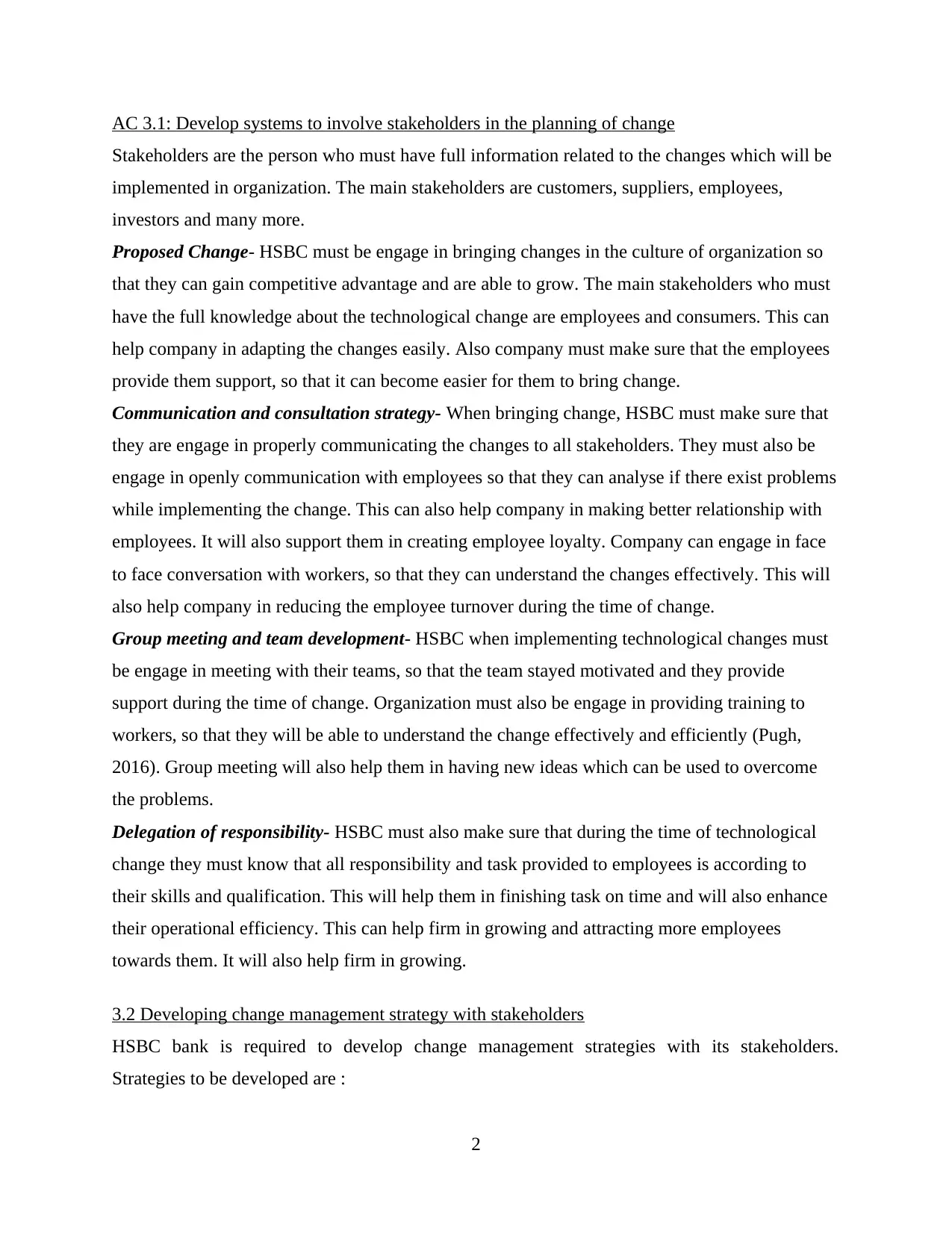
AC 3.1: Develop systems to involve stakeholders in the planning of change
Stakeholders are the person who must have full information related to the changes which will be
implemented in organization. The main stakeholders are customers, suppliers, employees,
investors and many more.
Proposed Change- HSBC must be engage in bringing changes in the culture of organization so
that they can gain competitive advantage and are able to grow. The main stakeholders who must
have the full knowledge about the technological change are employees and consumers. This can
help company in adapting the changes easily. Also company must make sure that the employees
provide them support, so that it can become easier for them to bring change.
Communication and consultation strategy- When bringing change, HSBC must make sure that
they are engage in properly communicating the changes to all stakeholders. They must also be
engage in openly communication with employees so that they can analyse if there exist problems
while implementing the change. This can also help company in making better relationship with
employees. It will also support them in creating employee loyalty. Company can engage in face
to face conversation with workers, so that they can understand the changes effectively. This will
also help company in reducing the employee turnover during the time of change.
Group meeting and team development- HSBC when implementing technological changes must
be engage in meeting with their teams, so that the team stayed motivated and they provide
support during the time of change. Organization must also be engage in providing training to
workers, so that they will be able to understand the change effectively and efficiently (Pugh,
2016). Group meeting will also help them in having new ideas which can be used to overcome
the problems.
Delegation of responsibility- HSBC must also make sure that during the time of technological
change they must know that all responsibility and task provided to employees is according to
their skills and qualification. This will help them in finishing task on time and will also enhance
their operational efficiency. This can help firm in growing and attracting more employees
towards them. It will also help firm in growing.
3.2 Developing change management strategy with stakeholders
HSBC bank is required to develop change management strategies with its stakeholders.
Strategies to be developed are :
2
Stakeholders are the person who must have full information related to the changes which will be
implemented in organization. The main stakeholders are customers, suppliers, employees,
investors and many more.
Proposed Change- HSBC must be engage in bringing changes in the culture of organization so
that they can gain competitive advantage and are able to grow. The main stakeholders who must
have the full knowledge about the technological change are employees and consumers. This can
help company in adapting the changes easily. Also company must make sure that the employees
provide them support, so that it can become easier for them to bring change.
Communication and consultation strategy- When bringing change, HSBC must make sure that
they are engage in properly communicating the changes to all stakeholders. They must also be
engage in openly communication with employees so that they can analyse if there exist problems
while implementing the change. This can also help company in making better relationship with
employees. It will also support them in creating employee loyalty. Company can engage in face
to face conversation with workers, so that they can understand the changes effectively. This will
also help company in reducing the employee turnover during the time of change.
Group meeting and team development- HSBC when implementing technological changes must
be engage in meeting with their teams, so that the team stayed motivated and they provide
support during the time of change. Organization must also be engage in providing training to
workers, so that they will be able to understand the change effectively and efficiently (Pugh,
2016). Group meeting will also help them in having new ideas which can be used to overcome
the problems.
Delegation of responsibility- HSBC must also make sure that during the time of technological
change they must know that all responsibility and task provided to employees is according to
their skills and qualification. This will help them in finishing task on time and will also enhance
their operational efficiency. This can help firm in growing and attracting more employees
towards them. It will also help firm in growing.
3.2 Developing change management strategy with stakeholders
HSBC bank is required to develop change management strategies with its stakeholders.
Strategies to be developed are :
2
Paraphrase This Document
Need a fresh take? Get an instant paraphrase of this document with our AI Paraphraser

Leveraging strategies
Leveraging strategies are used by those that are ready for accepting the change in initial stages
and are usually known as leaders of change since they motivate employees for accepting the
change. Leader motivate employees to accept the change by driving them toward the benefits
which will be acquired by accepting the change in organisation.
Engagement Strategy
Strategy of engagement is used by those stakeholders that are part of unwilling and reluctant
majority. Engagement strategy is used for inverting these reluctant employees of organisation in
easy adapters of change and using the employees as tool for convincing other employees of
organisation. The strategy convert the resisting employees by making appropriate
communication and identifying the reasons behind resistance. This strategy involves training and
educating employees about change.
Containment Strategy
Strategy is for resisting slackers that are not ready for accepting change but are competent.
These people contribute in change process therefore it is essential for the company to convince
them for the acceptance of change. These are the efficient employees whose contribution helps in
growth of business.
Outplacement strategy
Strategy is applied for people that are not for accepting the change. These stakeholders are
provide with required number of opportunities for accepting the change (Lewis, Cantore and
Passmore, 2016). When they do not accept change they are dealt with other ways.
For the change in HSBC all employees are required to be through help of change management.
3
Leveraging strategies are used by those that are ready for accepting the change in initial stages
and are usually known as leaders of change since they motivate employees for accepting the
change. Leader motivate employees to accept the change by driving them toward the benefits
which will be acquired by accepting the change in organisation.
Engagement Strategy
Strategy of engagement is used by those stakeholders that are part of unwilling and reluctant
majority. Engagement strategy is used for inverting these reluctant employees of organisation in
easy adapters of change and using the employees as tool for convincing other employees of
organisation. The strategy convert the resisting employees by making appropriate
communication and identifying the reasons behind resistance. This strategy involves training and
educating employees about change.
Containment Strategy
Strategy is for resisting slackers that are not ready for accepting change but are competent.
These people contribute in change process therefore it is essential for the company to convince
them for the acceptance of change. These are the efficient employees whose contribution helps in
growth of business.
Outplacement strategy
Strategy is applied for people that are not for accepting the change. These stakeholders are
provide with required number of opportunities for accepting the change (Lewis, Cantore and
Passmore, 2016). When they do not accept change they are dealt with other ways.
For the change in HSBC all employees are required to be through help of change management.
3
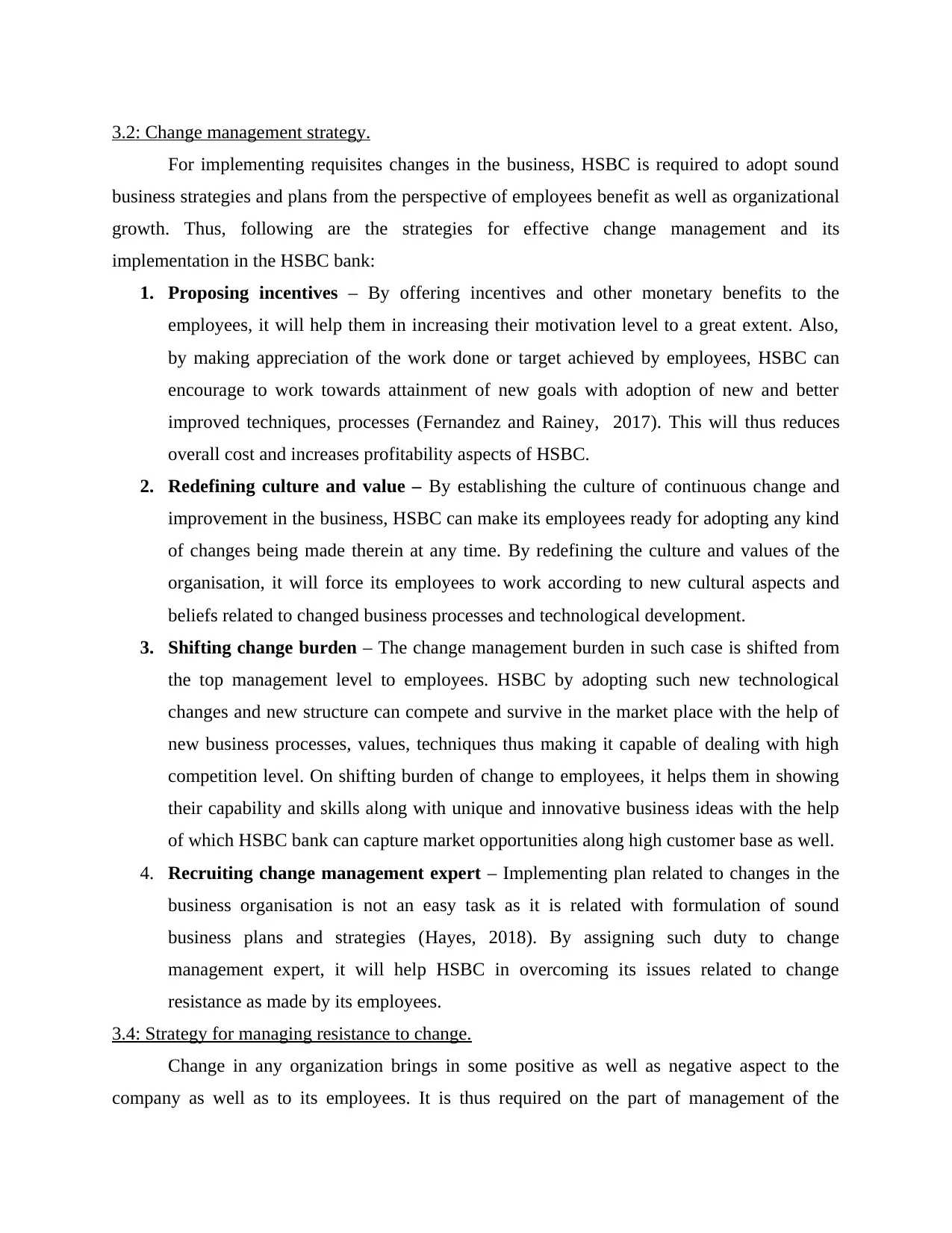
3.2: Change management strategy.
For implementing requisites changes in the business, HSBC is required to adopt sound
business strategies and plans from the perspective of employees benefit as well as organizational
growth. Thus, following are the strategies for effective change management and its
implementation in the HSBC bank:
1. Proposing incentives – By offering incentives and other monetary benefits to the
employees, it will help them in increasing their motivation level to a great extent. Also,
by making appreciation of the work done or target achieved by employees, HSBC can
encourage to work towards attainment of new goals with adoption of new and better
improved techniques, processes (Fernandez and Rainey, 2017). This will thus reduces
overall cost and increases profitability aspects of HSBC.
2. Redefining culture and value – By establishing the culture of continuous change and
improvement in the business, HSBC can make its employees ready for adopting any kind
of changes being made therein at any time. By redefining the culture and values of the
organisation, it will force its employees to work according to new cultural aspects and
beliefs related to changed business processes and technological development.
3. Shifting change burden – The change management burden in such case is shifted from
the top management level to employees. HSBC by adopting such new technological
changes and new structure can compete and survive in the market place with the help of
new business processes, values, techniques thus making it capable of dealing with high
competition level. On shifting burden of change to employees, it helps them in showing
their capability and skills along with unique and innovative business ideas with the help
of which HSBC bank can capture market opportunities along high customer base as well.
4. Recruiting change management expert – Implementing plan related to changes in the
business organisation is not an easy task as it is related with formulation of sound
business plans and strategies (Hayes, 2018). By assigning such duty to change
management expert, it will help HSBC in overcoming its issues related to change
resistance as made by its employees.
3.4: Strategy for managing resistance to change.
Change in any organization brings in some positive as well as negative aspect to the
company as well as to its employees. It is thus required on the part of management of the
For implementing requisites changes in the business, HSBC is required to adopt sound
business strategies and plans from the perspective of employees benefit as well as organizational
growth. Thus, following are the strategies for effective change management and its
implementation in the HSBC bank:
1. Proposing incentives – By offering incentives and other monetary benefits to the
employees, it will help them in increasing their motivation level to a great extent. Also,
by making appreciation of the work done or target achieved by employees, HSBC can
encourage to work towards attainment of new goals with adoption of new and better
improved techniques, processes (Fernandez and Rainey, 2017). This will thus reduces
overall cost and increases profitability aspects of HSBC.
2. Redefining culture and value – By establishing the culture of continuous change and
improvement in the business, HSBC can make its employees ready for adopting any kind
of changes being made therein at any time. By redefining the culture and values of the
organisation, it will force its employees to work according to new cultural aspects and
beliefs related to changed business processes and technological development.
3. Shifting change burden – The change management burden in such case is shifted from
the top management level to employees. HSBC by adopting such new technological
changes and new structure can compete and survive in the market place with the help of
new business processes, values, techniques thus making it capable of dealing with high
competition level. On shifting burden of change to employees, it helps them in showing
their capability and skills along with unique and innovative business ideas with the help
of which HSBC bank can capture market opportunities along high customer base as well.
4. Recruiting change management expert – Implementing plan related to changes in the
business organisation is not an easy task as it is related with formulation of sound
business plans and strategies (Hayes, 2018). By assigning such duty to change
management expert, it will help HSBC in overcoming its issues related to change
resistance as made by its employees.
3.4: Strategy for managing resistance to change.
Change in any organization brings in some positive as well as negative aspect to the
company as well as to its employees. It is thus required on the part of management of the
⊘ This is a preview!⊘
Do you want full access?
Subscribe today to unlock all pages.

Trusted by 1+ million students worldwide
1 out of 20
Related Documents
Your All-in-One AI-Powered Toolkit for Academic Success.
+13062052269
info@desklib.com
Available 24*7 on WhatsApp / Email
![[object Object]](/_next/static/media/star-bottom.7253800d.svg)
Unlock your academic potential
Copyright © 2020–2025 A2Z Services. All Rights Reserved. Developed and managed by ZUCOL.





